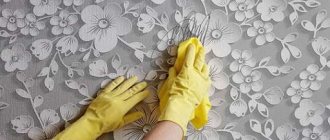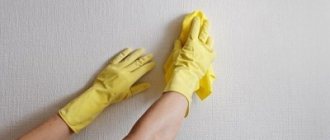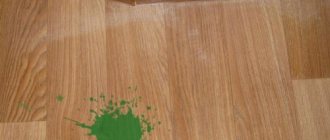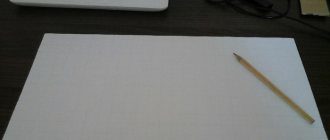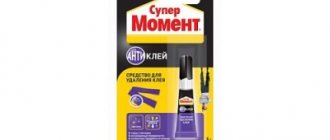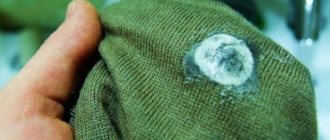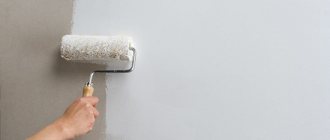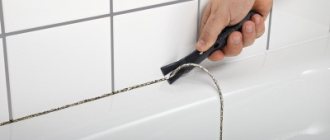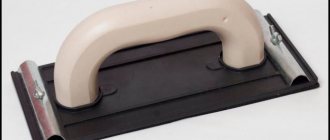Streaks on the walls create many problems for us. To remove them, you need to determine the cause of their occurrence. Organic stains are easy to remove. But stains that are the result of moisture and mold will be quite difficult to remove.
Painting surfaces with stains without determining the cause of their appearance does not make sense. If the cause of contamination is dampness in the room, then the walls must be dried before treating it.
Remove stains
The first step is to determine the origin of the contamination. Traces of organic origin are easy to remove. Leak or water stains are more difficult to remove. Each case must be considered individually.
Test the option that suits you best on a small area. The amount of the required composition is easy to calculate. The approximate quantity is usually marked on the container. The products contain acids, so it is important to follow safety precautions. Use gloves, goggles and special clothing.
Remove fat from painted, whitewashed
What to do if the water-based paint is stained? It is not easy to remove such contamination from the surface. The following tools will help with this:
- To remove grease stains from walls, use a regular detergent. Apply the composition for a few minutes, rinse the problem area with a damp cloth. The spots will disappear. Remember that you need to remove greasy formations before whitewashing, which will eliminate unsightly stains on the surface;
- Soda ash will help remove old greasy stains. Mix a few tablespoons of baking soda with ½ cup of warm water. Mix well and apply to the stain. Leave for 10 minutes. Rinse off any remaining product with water;
- If none of the options helped remove the greasy formation from the wall, then there is only one solution - re-painting. You will have to paint the wall with the same paint that was originally used for it. It is best to apply the paint in two layers. If the surface is colored, then you need to find an identical color so that the problem area does not stand out.
How to wash a marker in the entrance, in the elevator
Young artists often try to express themselves through creativity and do this in the form of drawings on the walls in the entrance.
Rubbing alcohol will help get rid of marker marks on walls.
Apply the product to the problem area and rub.
Remember that on colored surfaces, after using alcohol, the paint may peel off, leaving a white spot.
Treat the surface carefully, without unnecessary pressure. An ordinary sponge will help with this.
Find a solvent in the hardware department and use it to treat the marker mark in the elevator. After this, stains will remain on the surface. You can remove them with a shoe sponge previously moistened with silicone cream.
You can find marker remover at your office supply store. Dampen a sponge with this product and treat the problem area.
To remove marker stains in an elevator, use nail polish remover. Ethyl acetate is effective in removing marker marks on walls. Apply the product to a piece of fabric and treat the stain. ?Just like alcohol, it can remove the top layer of paint with regular use.
Remove glue from masking tape
After using the tape, sticky marks remain on the surface. The following tools will help you remove them:
- Vegetable oil. Apply oil to a rag and treat the dirty area. After 10 minutes, remove the glue with a napkin;
- Vodka or medical alcohol. Apply the product to the problem area using a cotton pad and carefully remove any remaining glue;
- Loose cleaning agent. Apply to a rag and work through the adhesive formation. Suitable for use on hard surfaces;
- Glass cleaning liquid. Spray the product onto the surface and wipe with a sponge;
- Soap solution. Dissolve the soap in water and heat the mixture. Apply to the problem area. Suitable for removing glue stains from fabric;
- Stationery eraser. The glue is erased from the surface in the same way as a pencil from paper. After this, wipe the area with a damp cloth. This method is suitable for removing stains from small areas;
- You can find a special cleaner in aerosol form in the hardware department. Spray the product on the surface and then wipe with a sponge;
- White Spirit. This product can be replaced with acetone. Handle the adhesive trace carefully so as not to spoil the surface.
Clean tobacco deposits from the toilet
A regular detergent, such as Fairy, will help get rid of nicotine deposits in the toilet.
Domestos and other chemicals containing chlorine can damage the surface.
The protective varnish film on the walls can be corroded by white spirit, gasoline, alcohol and nail polish remover.
Toilet tiles can be cleaned with regular soda. The grout in the toilet will be difficult to treat.
If a nicotine coating appears on such a surface, you will have to re-paint the seams on the walls.
Use cleaner to remove nicotine stains. You can find it in the hardware department.
It is much more difficult to remove smoking stains from dermantine.
Special household chemicals will help with this, which, if desired, can be replaced with any detergent, glass cleaning liquid or laundry soap solution.
Avoid products containing alkali.
Treat the surface slowly, without circular movements or pressure. Try to wring out the rag, otherwise the surface will take a long time to dry.
Output yellow
Few people are delighted with the yellow formations on the walls. They will ruin any beautiful interior. To get rid of yellow stains on walls, follow these steps:
- Remove wallpaper, clean off putty;
- If the wall is painted, treat the dirt with a damp cloth and remove the paint with a spatula;
- Take any bleach and apply it to a rag;
- Wring out the rag and treat the wall. If the contamination is small, then carry out the procedure in several stages, moving from one area to another. This way you treat the entire area of the stain. Repeat the steps until the contamination disappears;
- Wait until the wall is dry. If the stain does not disappear after drying, repeat the steps;
- Apply the primer to the problem area using a roller and leave to dry;
- Apply oil paint to the surface and leave to dry;
- Treat the wall with putty and leave to dry;
- Sand the surface with sandpaper, apply primer to the wall again;
- Apply the same paint as the ceiling and walls to the problem area;
- Paint the wall with base paint;
- If you apply another decorative coating, you don’t have to do the last two steps.
Removing stains from stretch and plastic ceilings
Due to their structural features, ceilings made of polyvinyl chloride and other polymers are most susceptible to fungal infection. The empty, hard-to-reach space between the ceiling and the film is an almost ideal environment for the growth of bacteria.
As a temporary measure, household laundry bleaches with a high chlorine content can be recommended. These products clean the surface, and their evaporation partially destroys the microflora, thereby slowing down the formation of fungus, but does not destroy it completely. It is advisable to find the strength and means to repair the ceiling in order to get rid of this “neighborhood” once and for all.
Otherwise, polymers are quite unpretentious. They are inert in their chemical composition, which is why they do not absorb most substances that create problems on other surfaces.
How to dry walls?
If the walls are damp, they must be thoroughly dried. This is the main condition for successful repairs. Natural drying of walls is a rather lengthy process. You can take modern methods, mechanical and chemical. We divide them into invasive and non-invasive. A non-invasive method, walls can be dried using special heaters (without exceeding the maximum air temperature of 35°C). It is very important to ensure proper ventilation of the room so that moisture can find its way out of the building. Other non-invasive methods are condensation and absorption dehumidification.
Invasive methods include injections, thermal injections and crystal injections, which is one of the cheapest and at the same time effective. Suitable for drying damp buildings, regardless of the type of material used for their manufacture, as well as the thickness of the walls and their degree of humidity and salinity. Regardless of the extent of the building's dampness, consult well about dehumidification methods with a professional company or simply hire one to carry out the work.
How to remove mold and mildew from a wall?
Stains may appear on damp walls as a result of the activity of microorganisms - bacteria or fungi. Removing dirt from the wall may not be enough. The cause of the infection must be determined. If the mold is the result of poor ventilation, it is quite enough to remove the layer of fungus, spray it with a suitable fungicidal agent, and then paint it with paint that will ideally cover the remaining trace of stains and also protect it from further development of microorganisms. If the house was flooded and the water brought with it spores of microorganisms, this may require the application of fungicides deep into the damaged wall. Only after identifying and eliminating the cause can we begin further work.
When to start painting walls?
Painting the wall
If the walls have been severely damaged and the plaster does not adhere to the base, you should knock off the old layer and apply a new one. However, if the plaster is tightly connected to the base, then you can limit yourself to filling and restoring defects.
Make sure the wall is dry before you start painting. Painting work can begin when the moisture content of mineral substrates (plaster, concrete, brickwork, fiber-mineral boards) does not exceed 3-6%, depending on the material. During painting, the room temperature should be in the range of 5-25°C, and the air humidity should not exceed 80%.
How to get rid of stains on walls?
Antiseptic coating
During the operation of premises, stains often appear on the walls or ceiling. Before you start painting, you need to get rid of them. It is especially important to remove oil, grime and nicotine stains as they weaken adhesion and may cause discolouration. To remove grease, you should use proven and reliable products, for example, paint thinner. You should not replace it with dishwashing liquid, because, as a rule, they contain polishing agents or substances that protect the skin, such as lanolin.
After washing and drying the walls, areas where there were stains should be painted over with special stain-isolating paint.
Cleaning thin wallpaper
If you use water to clean grease stains from thin wallpaper, there is always a risk of permanently damaging the facing coating. Therefore, for thin wallpaper it is better to use dry cleaning methods. These methods include cleaning with gasoline. It is only advisable to use regular potato starch instead of tooth powder.
To deal with mold stains, it is recommended to ventilate the room properly to get rid of dampness. If the stain is constantly growing, you will have to completely re-glue the piece of wallpaper using special technologies.
- Cleaning a fragment of a wall from scraps of paper;
- After this, you need to ventilate the room;
- Apply primer to the wall;
- Select the adhesive composition.
What paints can be used to paint over stains on walls?
Renostil Plus is an insulating paint designed for painting over stains after cleaning the surface from water, grease, soot and cigarette smoke. Strengthens the base, protects it for a long time from exposure to moisture and the development of mold in rooms such as bathrooms and kitchens.
Fresh Start Primer 023 is a water-based, acrylic primer paint that perfectly seals out grease stains, water stains and rust (for example, from plumbing accidents), graffiti, nicotine residue, bitumen stains, soot (for example, after a fire), as well as marks from pencils.
Everal Primer is a matte alkyd paint for priming putty surfaces, as well as previously painted surfaces with lime paints or glue, as well as wood, concrete, plaster, brick, plaster. Isolates stains that have penetrated deep into the base.
Sniezka from smudges and stains is an acrylic paint for painting and restoring plasters, cement-lime, concrete surfaces, plaster, drywall, etc. It isolates stains after cleaning the base from water, soot, nicotine and fats. Can be used as a paint and primer or external coating.
postroy-sam.info
Stains on vinyl and non-woven wallpaper
Are you tormented by the question of how to remove greasy stains from painted vinyl and non-woven wallpaper? We will help.
If you try to immediately paint over the stain with acrylic, then 99% of the time you won’t succeed, since the greasy mark will easily “break through” through the new layer of paint. The instructions for skilled hands will be as follows:
- — Remove as much greasy trace as possible using detergent,
- — We prime the wallpaper,
- - Paint over the stain.
To remove grease, you can and should use a dishwashing detergent with a similar effect , for example, Fairy or Frosch. Dissolve the solution in water in a ratio of 1 to 8-10, carefully apply to the stain and press for several minutes with a damp cloth. If the grease is deeply absorbed, the procedure must be repeated several times, just do not rub the area of the defect, otherwise you will damage the top layer of wallpaper.
The greasy mark is gone, but there is still a stain from paint damage? Let's move on to the second part of the instructions. Apply a primer, for example, Sniezka or Tikkurila, to the area of the former defect, covering the adjacent areas of the wallpaper. Wait for the primer to dry and apply two layers of acrylic paint to the entire surface where the stain was (at least 4 hours interval). It is advisable to use the same brand of paint as the primer.
If your vinyl or non-woven wallpaper is not painted, then the procedure for removing stains is similar, just be more careful when working with detergent and skip the step of priming and painting the wall.
For a shallow and fresh stain, it is enough to hold the rag with the solution for a minute once, but if the damage has penetrated deeply or has been distressing the eye for a long time, then the procedure can and should be repeated up to 5-6 times.
The effectiveness of this method is 90%, the main thing is not to go into a rage and rub a hole in the wallpaper - this is original, of course, but ugly.
Recommendations
Advice and recommendations from experts will help you cope with the task of removing greasy stains from surfaces as effectively as possible:
- To remove grease, do not use tools with abrasive surfaces, as this may harm the material.
- The choice of cleaning product should take into account not only the type of material, but also its condition.
- Excessively moistening the stain will not help remove it faster, but it can ruin the material itself.
- If there is any doubt about the suitability of using a particular stain remover, it is advisable to test its effect on an inconspicuous area.
- If the stained wallpaper is old, and the grease stains are extensive, then the best option is to replace them, since it is unlikely to be possible to remove large stains without leaving a trace.
- Some stain removers (both homemade and store-bought) have a strong odor, so it is advisable to carry out all cleaning work in good ventilation.
You can learn how to remove a grease stain from a T-shirt here, from a jacket - here, from pants - in this article, from leather and suede - in this article.
Stains on paper wallpaper
If grease stains appear on paper wallpaper, then there is more work and there is no guarantee of a positive result, because it is not easy to completely remove grease from the fabric and not damage the top layer of wallpaper.
Try using crushed chalk to remove greasy marks. Limestone is crushed to a powdery state, poured into a damp cloth and pressed onto the stain. The procedure may have to be repeated many times, but if the stain is not old, then there is a high probability that the chalk will draw out the grease.
For the freshest stains, you can use gasoline or acetone, which is moistened with a clean (!) rag and applied to the defect. Gasoline breaks down fat, but the smell can remain in the apartment for a long time, so start with chalk and move on to solvents only as a last resort.
Detergents are not used when removing stains from paper wallpaper - it will quickly soak the material and even after removing the grease, a mark will remain on the wall.
Some try to apply toilet paper to the stain and iron it with a very warm iron, but this method did not work for us - the standard approach helped: chalk, primer, repainting a section of the wall.
Answers on questions
Can stains be removed using a salt cloth and an iron?
If the stain is not old, it is possible, but in this case it is also possible to get rid of the wallpaper - it can simply come off the wall.
If you paint over a stain three or four times, will it disappear?
No, the greasy stain will not disappear - the grease will easily break through the paint, and perhaps it will only fade. First you need to remove as much fat as possible, then prime, then paint.
stroyremontiruy.ru
chonemuzhik.ru
Painting the walls is the best option to ensure your walls always look clean. External factors - humidity, bright rays of the sun, spots planted carelessly. You should regularly monitor the cleanliness of the walls and clean their surface.
If your walls are painted, then you have often faced the problem of how to clean the dirty surface. These could be stains from tea, dirty hands, splashes, and so on. Sometimes paint drops fall on the wall while painting the floor. It turns out that this is not a problem if you know what the stains are.
If you cannot remove the stain, or do not know its origin, then you will have to remove some of the paint. Next, you need to prime the area and prime it in an even layer. If you notice that the paint is of poor quality, then you will have to repaint it after removing the old paint. First prime the wall. If the wall was doused with water, then the wall just needs to be washed.
If the painted wall has a textured surface, or it is painted with light paint, then it is better for you to repaint the wall with the same paint. Walls painted with oil paint can be washed with detergent or soap. Do this more often and the walls will smile at you with cleanliness. If the walls are painted with acrylic paint, then you can buy special soap or detergent for acrylic paints on the market.
If there are marks on the walls from rubber soles or pencils, they can be erased with an eraser. The remaining stains are cleaned with special detergents. If a stain on the walls was caused by a felt-tip pen, pen or pencil, it can be washed off with plain water. If the stain is difficult to remove, add detergent (the kind you use to wash dishes).
The technology for washing walls is quite simple: for the first time you need to wash it off from below. The second time the wall is washed from above. Change the water often, and then wipe the walls with a dry cloth. If the stain still does not wash off, you will have to choose a paint color and paint the wall.
If you want the wall to have a glossy appearance, after washing, wipe it with a suede cloth. Do not rub the walls with household appliances that you use to clean the tiles or sink. If the walls were painted with emulsion, the paint is washed off with warm water. In this case, erase the stain with an eraser and then wipe with a damp cloth.
If you have painted the walls, you should wash them no earlier than after two to three weeks. Then the paint will adhere well to the walls, and you will be able to monitor them regularly.
We wish you clean walls.
bigcleaning.ru
Removing oil stains from the ceiling
The process of removing oil stains from the ceiling is a troublesome task. The difficulty of the work lies in the fact that the oil penetrates strongly into the plaster, therefore, even after removing the layer of lime, puttingtying and painting the ceiling several times, over time you can again encounter the appearance of oil stains. To remove oil stains from the ceiling, you need to follow a certain algorithm of actions:
- We clean the problem area from dust and dirt.
- We prime the oil stain.
- We are waiting for the primer to dry.
- Pour the paint into the tray and, using a roller, paint over the stain.
- Areas that are difficult to paint with a roller are carefully painted over with a brush.
- Having painted over the spots on the ceiling with one layer of paint, wait for it to dry completely.
- If the stain does appear, you should paint over it several more times until it completely disappears.
- After which it is better to wait a few days and, if the stain does not appear, you can begin work on repairing the ceiling.
Chalk
How else can you remove greasy stains from washable wallpaper? You can remove grease with chalk, which perfectly absorbs all dirt. Grind the chalk to a powder and then apply to the problem area. After a few minutes, the chalk powder will absorb the greasy residue, and all that remains is to wipe the wallpaper with a dry cloth.
Petrol
Gasoline is an excellent option for removing grease stains from walls. But the product should be used very carefully so as not to damage the surface.
The contaminated area is wiped with a cloth soaked in purified gasoline. You can apply a rag soaked in gasoline to the mark for 10 minutes. The greasy mark will dissolve very quickly.
Folk remedies in the fight against fat
To remove grease from walls covered with wallpaper, you can use the following “folk remedies”:
- Napkins and iron. Place a paper towel on the dirty wall, heat the iron and run it over the sheet. Be careful not to use the iron to burn a hole in the trim. The napkin needs to be changed from time to time - the fat will saturate the thin paper;
- Stationery eraser. You can try to wipe away grease stains with a regular eraser. But in this case there is also a high risk of damaging the wallpaper;
- Chalk. Chalk powder perfectly absorbs fats. Rub the chalk into the stains, then brush them off with a brush or soft cloth;
- Petrol. If you are not afraid of ruining the brightness of the wall color, use gasoline and a cloth. The liquid dissolves fat in literally 1-2 minutes.

